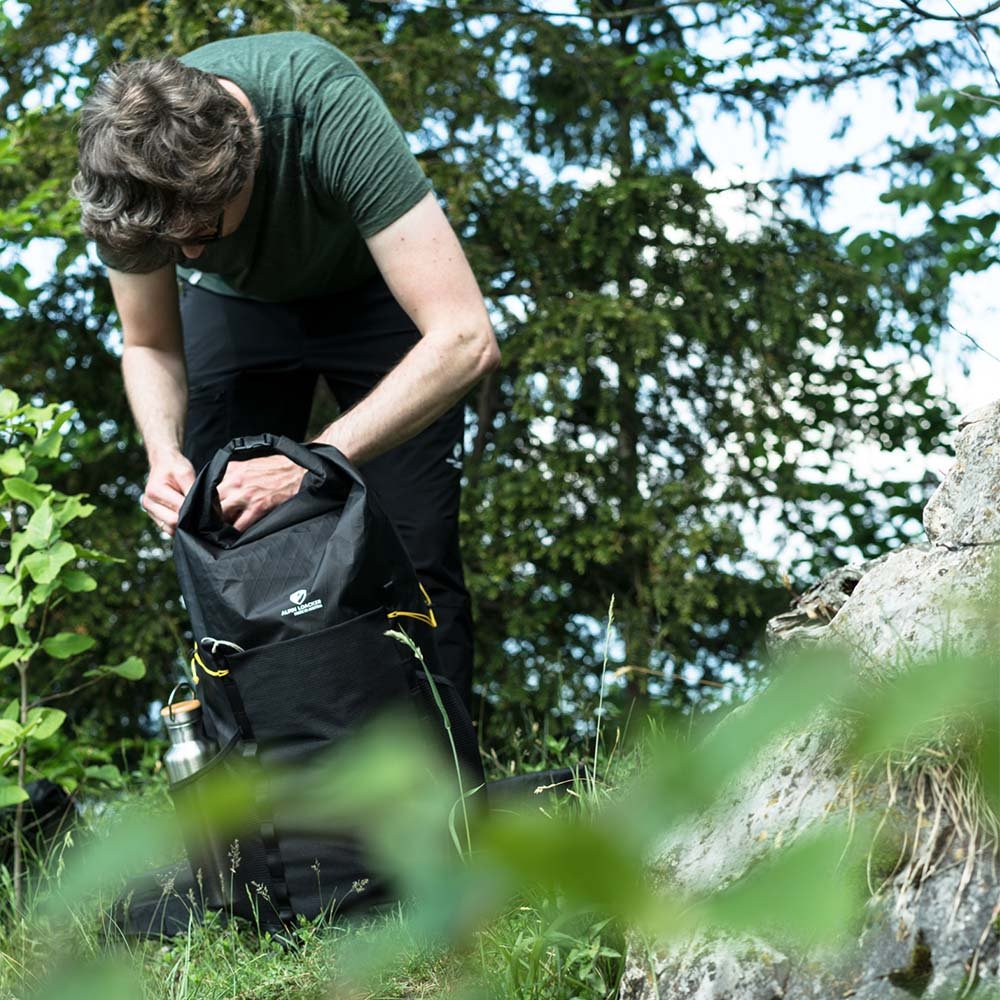Die zentrale Frage: Brauche ich einen wasserdichten Rucksack für die Berge?Diese Frage und die für Verwirrung stiftenden Begriffe, was der Unterschied zwischen wasserdicht, wasserfest und wasserabweisend ist, wird in diesem Blog Beitrag über wasserdichte Rucksäcke geklärt.
Was ist der Unterschied zwischen Wasserdicht, Wasserfest und Wasserabweisend?
Wasserdicht
Bezeichnet die Eigenschaft von Materialien und Kleidung die, das Ein- oder Durchdringen von Wasser verhindern. Wenn ein Rucksack als wasserdicht bezeichnet wird, so muss dieser zu 100 Prozent in der Lage sein, Nässe aus dem Inneren des Rucksacks fernzuhalten.
Wann ist etwas wasserdicht?
Es gibt unterschiedliche Klassen. Sie werden wie folgt eingeteilt: Nach der europäischen Norm EN 343 ist ein Produkt mit einer Wassersäule ab 800 mm „wasserdicht (Klasse 1&2)“, ab 1300 mm „wasserdicht (Klasse 3)“, ab 2000 mm „wasserdicht (Klasse 4)“.
Wann ist ein Rucksack wasserdicht?
Der große Unterschied zwischen wasserdichten und wasserfesten Rucksäcken sind die verschweißten Nähte. Nähte sind oft der Schwachpunkt, die mit der Zeit Nässe durchlassen. Bei einem 100 %igen wasserdichten Rucksack sind die Nähte verschweißt. Dies macht den Rucksack allerdings teurer und schwerer.

Dieser Bergrucksack von Alpin Loacker ist wasserdicht und hat keine verschweißten Nähte. Deshalb ist der Rucksack sehr leicht und bringt ein Gewicht von 394g auf die Waage.
Wasserfest
Wasserfestes Material lässt, im Vergleich zu wasserdichten Stoffen, Wasser durch - ABER erst nach einer gewissen Zeit!
Wann ist etwas Wasserfest?
Wasserfest bzw. Wasserresistent ist ein Rucksack, wenn er Nässe zwar abhalten kann, aber nicht ausgeschlossen werden kann, dass Nässe irgendwann eindringt. Wasserfeste Rucksäcke sollten im Normalfall für einige Stunden das Wasser aus dem Inneren des Rucksacks fernhalten.
Wie lange hält ein wasserfester Wanderrucksack, bevor er nass wird?
Ein wasserfester Rucksack ist für Wandertouren, die mehrere Stunden dauern, geeignet. Schüttet es wie aus Eimern kann es jedoch vorkommen, dass Nässe durchdringt.
Mit diesen zwei Hilfsmitteln kannst Du einen Rucksack wasserdicht machen:
- Wasserdichte, richtig - eigentlich Wasserfeste Werkstoffe, werden, falls sie nicht aus 100 % wasserdichtem Material bestehen, häufig durch Imprägnierung, wasserdicht gemacht.
- Nimm eine Regenhülle für den Rucksack mit, wenn Du Dir bzgl. des Wetterverlaufs nicht sicher sein kannst. Regenhüllen für Wanderrucksäcke gibt es in unterschiedlichen Größen. Gelegentlich ist eine Regenhülle im Rucksack schon mit eingebaut. Dann befindet sich diese oft im unteren Teil - im Boden des Rucksacks.

Wenn Du den Rucksack währen eines Fluges in die Gepäck Aufgabe gibst, schützt eine Regenhülle zusätzlich vor Verschleiß und Schmutz.
Wasserabweisend
Wasserabweisend sind Materialien, die das Wasser abstoßen, so dass es nicht durchdringen kann. Diese Materialien haben meist eine Beschichtung, die dafür zuständig ist, keine Nässe nach innen zu lassen. Diese Beschichtung ist das wasserabweisende Material. Wasserfest und Wasserabweisend werden oft synonym verwendet. Wasserabweisende Materialien sind weniger robust als wasserdichte Materialien.
Wann ist ein Rucksack Wasserabweisend?
Eine gewisse wasserabweisende Funktion ist bei jedem Outdoor Rucksack gegeben, weil er sonst nicht seinen Zweck erfüllen könnte. Das Material muss eine gewisse Zieh- und Reißfestigkeit besitzen. Materialien für einen wasserabweisenden Outdoor Rucksack müssen also eine gewisse Grund Robustheit mit sich bringen. Diese besteht in der Regel aus einem reißfesten Material, das über längere Zeit Gewicht halten kann, ohne seine Elastizität zu verlieren und ohne Wasser aufzunehmen.
Ein Wander Rucksack kann leichten Regen bis zu 2 oder 3 Stunden aushalten. Dann fängt er an durchzufeuchten. Hier ist es ratsam, schon von Anfang an eine Regenhülle zu verwenden, um keine Feuchtigkeit in den Rucksack zu bringen.

Fast alle Outdoor Rucksäcke, die nicht wasserdicht oder wasserfest sind, sind Wasserabweisend. Außer spezielle Leichtrucksäcke, bei denen Wasser sofort durchdringt.
Tipp: Wenn Du keinen komplett wasserdichten Rucksack hast, verwende einen wasserdichten Packsack, auch Drybag genannt, für elektronische Gegenstände wie Handy und Kamera.

Ein Drybag bzw. Packsack schützt Deine elektronischen Geräte vor Nässe.
Wann brauche ich unbedingt einen wasserdichten Rucksack?
Einen wasserdichten Rucksack solltest Du unbedingt für folgende 2 Aktivitäten benutzen:
- Zum Klettern: Wasserdichte Rucksäcke fürs Klettern sind extrem widerstandsfähig, weil sie dem Fels so lange wie möglich standhalten müssen. Sie sind meist aus LKW-ähnlichen Planen wie TPU oder ähnlich robusten Stoffen gemacht.
- Zum Biken: Die meisten Rucksäcke und Fahrradtaschen sind mittlerweile komplett wasserdicht. Hier droht nicht nur Nässe von oben und von der Seite, sondern auch Schmutz und Schlamm vom Boden.

Rucksäcke die am Fels entlang geschleift werden müssen extrem robust sein.
Urbaner Bereich und täglicher Gebrauch
Wer das ganze Jahr mit dem Fahrrad unterwegs ist und elektronische Geräte wie Laptop und Handy transportiert, hat folgende Möglichkeiten:
Entweder kannst Du auf einen komplett wasserdichten Rucksack mit verschweißten Nähten zurückgreifen oder einen wasserfesten Rucksack, sprich ein Rucksack, bei dem das Material wasserdicht ist, aber keine verschweißten Nähte hat. Hier ist es sehr wichtig, dass du einen Rucksack wählst, der von oben zusammengerollt wird und nicht durch einen Reißverschluss geöffnet und geschlossen wird. Der Rucksack sollte auf unnötige Nähte verzichten. Am besten geeignet dafür ist, wie viele moderne Modelle, eine Art schnörkelloser "Sack''. Dieser hat den Vorteil, dass er leicht ist und du nicht unnötiges Rucksackgewicht rumschleppen musst.

Leichter und wasserdichter Rucksack für den Alltag oder Tagestouren.






